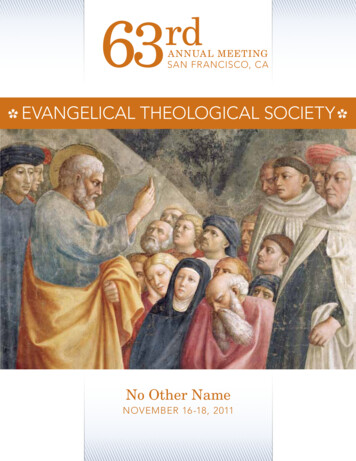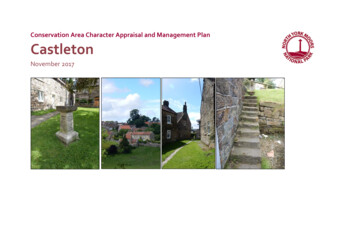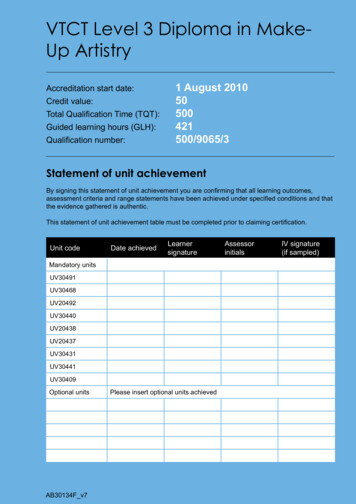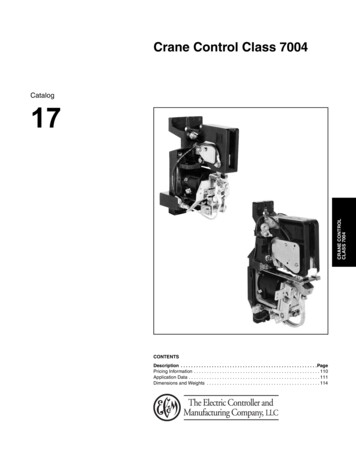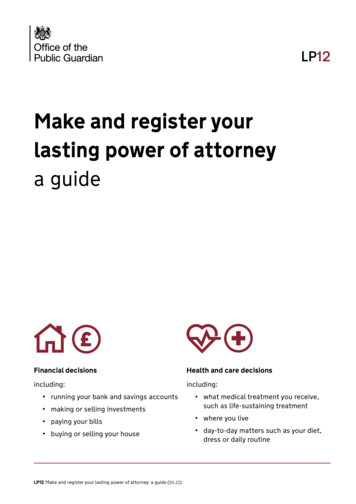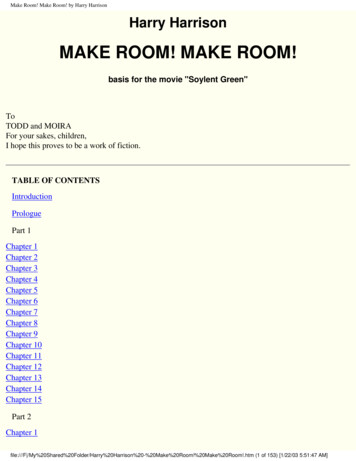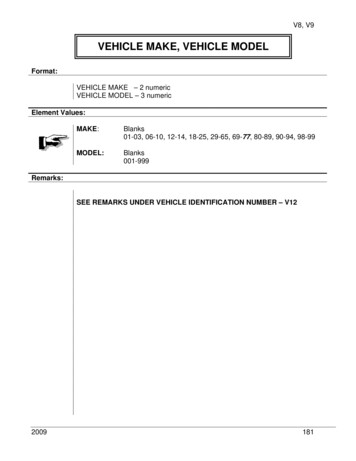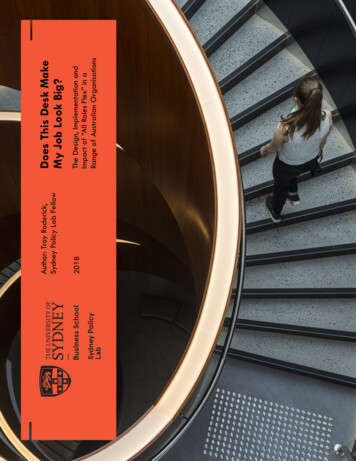
Transcription
Does This Desk MakeMy Job Look Big?The Design, Implementation andImpact of “All Roles Flex” in aRange of Australian OrganisationsAuthor: Troy Roderick,Sydney Policy Lab Fellow2018
2
ContentsIntroduction . 4The importance of “All Roles Flex” . 5Extant research on flexible work . 5‘All Roles Flex” in practice—emerging themes . 6Why do organisations adopt “All Roles Flex”? . 7What are the organizational enablers of effective “All Roles Flex”? . 7What outcomes can organisations expect and what’s next? . 8Case studies of “All Roles Flex” approaches . 9Aurecon . 9Crown Resorts . 13Department of Environment, Land, Water and Planning (Victoria) . 16Medibank. 19PwC Australia. 22NSW Transport Cluster . 25Unilever Australia and New Zealand. 28Westpac Group . 31Conclusion. 34About the Sydney Policy Lab . 35About Troy Roderick. 36Research Team . 36References. 37Appendix—Interview Questions. 383
IntroductionWith the increasing focus on the value of inclusion, gender equality, shifting age dynamicsand the availability of technology, expectations of where and when work happens arechanging. The opportunity for flexible work brings an aspiration for new ways ofworking, but can be met with apprehension about what will be lost. The desire byemployees and their leaders to enable more flexible ways of working and the apparentinterest in retaining older models of ‘face-time’ and ‘presenteeism’ co-exist, sometimes inthe same organisation and culture. The ‘face-time’ and ‘presenteeism’-based models ofwork expect employees to be physically present in a particular location for long hours.They restrict flexible work options to certain needs of employees, like parenting. Moreprogressive employers are boldly trialing and adopting approaches that provide accessto flexibility for everyone, in every role, for any reason.Organisations are mainstreaming flexible work, called “All Roles Flex”, across a range ofindustry sectors, role types, levels of seniority and in various commercial contexts.Organisations adopting an “All Roles Flex” approach are starting to achieve sustainablebenefits for their people and their businesses.This Discussion Paper explores ways to understand and ultimately to disrupt the genderednorms on access to flexible work, enabling organisations and individuals to adopt newpractices that expand flexible work to a broader range of employees and extend its well-known impacts on organisational performance and gender equality (Ali et al., 2015;Diversity Council Australia, 2012, 2013, 2018; Sanders et al., 2016).Existing academic and industry research was reviewed, and face to face or phoneinterviews conducted with representatives of eight organisations in a range of industries.Data provided by these organisations was reviewed. Organisations were selected basedon their size and scale, variety of role types, industry sector and evidence of the impact of“All Roles Flex”.This Discussion Paper aims to: summarise the experiences of organisations that have implemented “All Roles Flex”style approaches to flexible work demonstrate both collective and specific barriers, advantages and impacts of theseapproaches use these experiences to guide other organisations inspire an increase in the uptake of flexible work by men and women in Australianworkplaces.4
The importance of “All Roles Flex”“All Roles Flex” was first implemented across Telstra, a major telecommunicationscompany headquartered in Australia, in March 2014 as a new approach to flexiblework to make flexibility available to employees in all roles. Flexibility became thestarting point for work, meaning “yes” was the new default response to requests forflexibility. Leaders were required to explain a significant negative business impact ifthey wanted to refuse a team member’s request. Since 2014, many other organisationsincluding major banks, energy retailers, professional services firms, emergency serviceproviders and the New South Wales and Victorian public sectors have introduced orsignalled intentions to introduce similar approaches. There is strong interest in initiativesmodelled on “All Roles Flex”, but a framework for implementing the approach, takingthe perspectives of all key stakeholders into account, is yet to be fully developed.Flexible work remains an elusive practice in many Australian workplaces. Data releasedby the Workplace Gender Equality Agency (2018) shows that over two-thirds ofAustralian organisations (70.7%) in 2017-2018 have either a policy and/or a strategyfor flexible working arrangements, up from 60.2% in 2014-15. At least 2 millionworkers work in organisations that have no flexible arrangements in place. As WGEAdata covers only 40% of Australian employees in private sector organisations with morethan 100 employees, the gap in practice may be much larger, for example amongsmaller businesses and in organisations with a policy on flexibility, but without supportingpractice to make it a reality.Extant research on flexible workA significant body of research explores barriers to and opportunities for enabling andincreasing the uptake of flexible work (Brough et al., 2009; De Cieri et al., 2005;MacDermott, 2016; Pocock, 2005; Pocock and Charlesworth, 2007), but there is a needfor detailed case studies to assist practitioners and academics understand and enable amainstreamed approach to flexible work across industry sectors, organisations and roles.A substantial body of industry and advocacy research comprehensively examinesbarriers and opportunities for flexible working for individuals (Catalyst, 2013; DiversityCouncil Australia, 2012, 2013, 2018; Sanders et al., 2016), providing a strongfoundation to explore the detailed application within specific industry, role ororganisational settings.Other current research explores the legislative settings which are intended to enablemore flexible ways of working (Cooper & Baird, 2015), but the evidence of practicesuggests there are still significant cultural and leader-capability barriers to realising thispotential, and that organisational barriers are the primary driver of a lack of access toflexible work for all.There is an opportunity to examine the practice of flexible work beyond parentingresponsibilities and managerial or professional roles. There is emerging research onmen and flexibility, particularly on the impact on the broader agenda of genderequality, but this focuses on parenting and sharing domestic care (Diversity Council5
Australia, 2013). While this research is valuable in expanding the traditional focus onhow women access flexible work, it could be complemented by research to guideorganisations in the practical steps on mainstreaming flexible work, to drive action basedon industry experience.Access to flexible work appears to be gendered. Research shows that men are lesslikely to ask for flexible work and more likely to be refused, and are thus less likely thanwomen to access flexible work (Diversity Council Australia, 2013; Chief ExecutiveWomen / Bain; Sanders et al., 2016; and Skinner et al., 2012). This impacts theopportunity for men to share dependent care and domestic responsibilities. Women’sworkforce participation is limited by established practices and outdated masculine andother gendered norms.The most recent evidence suggests that only managers and professionals are workingflexibly in any great numbers (Cassels et al., 2018), and that working flexibly continuesto result in career penalties for many employees. There is a need to highlight examplesof mainstreaming flexible work beyond management and professional roles, and toprovide insight and resources to help leaders support flexible work in their teams andorganisations, whatever the industry or role type.The literature reviewed is almost exclusively based in human resources practice andgrounded in a narrow definition of “work-life balance”, although Tomlinson et al. (2017)highlight the need to explore more macro contexts, examining individuals and identities,organisations and institutional settings.“All Roles Flex” in practice — emergingthemesTo examine the implementation and impact of “All Roles Flex” across a range ofindustries and organisations, eight organisations are profiled in mini case studies. Keystakeholders in each organisation were interviewed by the author on their motivations forintroducing “All Roles Flex”, the specifics and the nuances of the approach taken, and theoutcomes and results of mainstreaming flexible work. The eight organisations includedboth private and public sector employers in finance, manufacturing, transport, consultingand health services. High-level and common themes are summarised below, followed bythe individual case studies on each organisation.Some employers also indicated flexible ways of working would help them to tailor theirservices better to the needs of customers, match the ways of working of their customerorganisations or simply stay ahead of competitors in their industry.6
Why do organisations adopt “All Roles Flex”?There are several motivatorsMost organisations interviewed were very aware that access to flexibility is a key driverof employee attraction across age groups, gender and types of employment.Employers realise that current and prospective employees expect them to be bold andcreative in offering different ways to access flexible work, whether through activitybased working environments, policy shifts, and technology to enable shift swapping orinnovative approaches to enable more secure flexible work. This focus on the pull-factorof flexibility has driven a range of responses from employers keen to keep the bestpeople and manage turnover costs.Some employers also indicated flexible ways of working would help them to tailor theirservices better to the needs of customers, match the ways of working of their customerorganisations or simply stay ahead of competitors in their industry.What does “All Roles Flex” mean?“All Roles Flex” takes different shapes in different contextsFor many organisations, mainstreaming flexible work is framed as a policy approach asthe key driver for action and change over time. For other organisations, the formadopted for “All Roles Flex” is a sudden and disruptive gesture that brings in change topolicy and practice, and clear expectations of a new way of working more immediately.“All Roles Flex” can respond to a particularly timely opportunity (to address staff surveyresults or follow the practice of a customer organisation), offer a chance to be a firstmover in an industry or follow the specific nature of a type of role with technology tosupport flexible rostering or a new type of flexibility in a seasonal factory setting.Go hard (or go slow), but get goingSome organisations implemented “All Roles Flex” in staged approaches, preferring topilot, collect and analyse data and then make the case for a larger rollout. Otherorganisations took a deliberately ‘disruptive’ approach, to flick a switch and turn on “AllRoles Flex” overnight. Whatever the approach – and there are pros and cons of both –the case studies demonstrate there is never a time when all the conditions are perfect andrisk-free for a business, and that making a start and taking that first, but imperfect, stepis well worth it.What are the organisational enablers of effective“All Roles Flex”?Leadership mattersIn the case studies, the role of leaders is key. All the examples have a leader or team ofleaders at the centre, whether a bold step forward by a CEO who adopts “All RolesFlex” as a signature initiative or a senior leader adopting a visible position to championmore flexibility and convincing others in the business to follow. Leadership operates at7
both macro (whole-of-organisation) and personal (team leader and team member)levels. Good, inclusive leadership enables improved performance where mainstreamedflexible work is in place.Expect courage, and support your leaders to lead in new waysThe case studies demonstrate that the ambition to go “All Roles Flex” must be matchedby actions to develop and support leader capability to manage flexible teams. It cannot be assumed that all leaders have the experience and understanding to effectivelymanage flexible workers, especially if they have developed their own leadership stylesunder other leaders with more traditional expectations. Offering support and guidanceto leaders and managers, along with the opportunity for them to learn along the way, isa key condition for impact, and allows them to be courageous enough to try new waysof leading.Remain ambitious and creativeAll the case studies are based on ambitious approaches that either start with a “yes” toflexible work and expect creativity where a “yes” may be challenging for a specificrequest, or do not allow “no” at all and require a significant shift in mindset and practiceto live up to the big expectation. At either end and within this spectrum, there must beenough flexibility to keep pushing the boundaries to create new ways of working.Technology will continue to enable new and creative approaches, and employeeexpectations will require employers to adopt an open and inclusive approach toflexibility. For those employers adopting “All Roles Flex” now, continuing to be ambitiouswill prevent complacency and ensure “employer of choice” status among increasinglydiscerning employees.Keep the promise of flexibility in practiceA common feature in the case studies is that organisations have taken authentic steps tobe deliberate about the promise of flexibility within their employment brand andrecruitment processes. They have matched this promise in the real employmentexperience inside the organisation. They work to make sure their leaders are bothsupportive of flexibility in their teams and are role modelling flexible ways of workingthemselves.What outcomes can organisations expect andwhat’s next?The research plays out in practiceEach case study presents the outcomes and impacts from the adoption of “All Roles Flex”in a specific context. The collection of practical examples and data demonstrate thepositive results of mainstreaming flexible work. The case studies show that the long-heldand theoretical models that link flexibility to engagement, performance and diversityoutcomes are supported by practical examples.Consider the bigger pictureAlthough the impact data in the case studies largely focuses on the recruitment andemployment outcomes of adopting “All Roles Flex”, it shows the opportunity for impactbeyond these aspects on societal factors such as environment, urban planning andtransport, and on cultural factors such as inclusion, engagement and innovation inworkplaces. The conclusion proposes elements for future consideration.8
Case studies of “All Roles Flex” approachesAureconNumber of employees2800Types of workOffice-based, client siteWork locationsThroughout Australia and New ZealandScheduled/non-scheduled workNon-scheduled, no start and finish timesIndustry sector:Professional, Scientific and Technical ServicesCustomers/clientsOther firms and businessesBegan “Yes Flex”Planning 2014, go-live 2015 in a staged approachContext for flexible workAurecon’s journey to “Yes Flex” began with the overt championship of their Managing DirectorAustralia and New Zealand to take a disruptive step to improve the employee experience of alarge number of Aurecon employees and position the organisation as a leader in being morediverse and inclusive. The leadership team also wanted to openly challenge the prevailing viewwithin the firm that clients expected Aurecon’s employees to be bound by desk-time and apresenteeism mindset. They wanted to show that this expectation was a myth. Overall, therewas an inspiring objective at Aurecon to try a bold new approach and step outside theconstraints of traditional ways of working.Aurecon’s exit interview data showed the business was losing talented people because of a lackof flexibility for both women and men, effectively writing the “business case” for “Yes Flex”.Overall approachAurecon took a staged approach to implementing “Yes Flex”, knowing the ambition wouldrequire support for leaders as well as human resources colleagues in a new paradigm.The first step was to identify a pilot group. Aurecon Brisbane office’s Built Environment businessunit was chosen because this group was traditional in the way it worked and was maledominated, based on a building industry culture. After an initial reticence to trial more flexibleways of working, the leader of the Brisbane office conducted closer consultations within theteam, found there was a significant opportunity to improve access to flexible work, and shebecame a champion for “Yes Flex”. The leader also brought a major construction client into theprocess of exploring flexibility, focusing specifically on their experience of service levels fromAurecon. A three-month pilot revealed that the Aurecon team was happier, more engaged andstill able to deliver to their client’s expectations. The leader then became a more visibleflexibility champion across the business, regularly conducting workshops and peer coachingconversations to enlist more supporters and teams within Aurecon. This voice of a business9
leader, not human resources, was very powerful, and on 1 July 2015, Aurecon went live with“Yes Flex” across the organisation, with a variable runway for each business unit to prepare forlaunch.Following the launch of “Yes Flex”, small groups of line managers worked with their local seniorleader and explored their individual apprehensions and needs. The impact of this purposeful,localised and meticulous approach was that line managers felt heard and became morepositive about the change. As each location went live with “Yes Flex”, the local leader led staffpresentations for employees to share their experience of managers who were not supportive of“Yes Flex”. These leaders were then coached to be more supportive and enabling of flexiblework, in the knowledge that they too were supported by their own leaders to implement “YesFlex”.Recruitment approachTo support employee recruitment and provide an external face for “Yes Flex”, Aureconobtained external accreditation of their approach to flexible work. Aurecon was the firstorganisation in its industry to receive accreditation, where a third party assessed their approachto flexibility against good practice, and it positioned the organisation as a first-mover in moreflexible ways of working. “Yes Flex” became very visible in advertisements and in therecruitment process itself.Types of rolesMost employees at Aurecon are office-based professionals with a large proportion who visitclient sites to do engineering and surveying work, and then return to the central Aureconlocation. Some employees are on client sites for longer periods. Across the hundreds ofdifferent types of roles, the main categories are engineers, drafters, scientists, surveyors anddigital-based roles.Policy settingsThe main policy feature of “Yes Flex” was that leaders were not permitted to refuse a requestfor flexible work, unless evidence was provided that work delivery would be significantlyimpacted. Employees requesting flexible work were not required to give a reason for theirrequest and every request received a positive response.Leaders were strongly encouraged to “Leave loudly” by visibly declaring their commitmentsoutside work if they were leaving the office to attend a family commitment earlier than theusual end of day and role model flexible ways of working, which has had a significant impactof the behaviour of other employees, and increased the level of trust on flexible ways ofworking.As part of “Yes Flex” Aurecon changed employment contracts so there are no start and endtimes, just an agreed number of hours, and it is up to each employee and their manager andcolleagues to establish the most effective working pattern to achieve results. To support this,Aurecon developed a toolkit and refreshed their flexible working policy, and is moving to“cartoon contracts”, which present complex legal information in more simple terms using mindmaps and illustrations.10
Challenges and opportunitiesAurecon found the greatest initial challenge was supporting their line managers to move to anew and more inclusive way of leading. This challenge was met by a constant and persistentfocus on the overall objective of new ways of working, and the leadership provided by leadersin various locations, who directly addressed any backlash.Challenges that were more system-based, for example timesheets and a requirement in the HRsystem to enter a certain number of hours, were addressed by removing this requirement whenthere was the opportunity for a system reset and a retrofit was possible.The greatest technology challenge was with the occupational group of drafters who usedtechnology that is not multi-licensed. This made it more difficult for the technology to be madeavailable via laptops, potentially limiting location-independence for this role. Aurecon met thischallenge by purchasing a very high-speed laptop, setting it up with the required licence andenabling it to be booked and borrowed by those who wanted to work outside the office.What made “Yes Flex” easier at Aurecon was the very clear and intentional support from thetop, with senior leaders expressing a clear expectation across the business. Leaders steppingup as examples to their peers and others was also important for success of the overallapproach.Using Yammer as an internal communications tool to promote examples of flexible work alsoincreased visibility and the embedding of more flexible ways of working.Outcomes and impactAurecon does not count uptake of flexible work as it is redundant in an entirely “Yes Flex”environment and does not conduct engagement surveys. Outcomes and impact include: More people say they have the flexibility they need. As part of Aurecon’s data gatheringfor the WGEA Employer of Choice for Gender Equality citation, employees indicating theyhave the flexibility they need to balance work and other commitments increased from 89%overall in 2016 (90% for men and 80% for women) to 92% overall in 2018 (91% for menand 93% for women). More men are taking primary parental leave, increasing from 7% in 2016 to 22% in2018. The representation of female employees increased from 26% overall in 2015 to 32%overall in 2018. There is significant interest in flexible work in internal communications: the “Yes Flex”launch article at Aurecon had 200% more online traffic during its launch month than anyother article. Reasons for exit changed. A lack of flexibility moved from being a top 5 reason in 2015to not being mentioned at all within exit interview surveys now. There is no negative impact on client service. Key clients indicate they see no negativeimpact on the service levels they receive from Aurecon and some clients have engagedAurecon to help them implement their own approaches to more flexible ways of working. InMarch 2017 Aurecon ran two Design to Innovate workshops with an infrastructure client toexplore the current state of diversity and inclusion, including flexibility. One of the key11
barriers identified was a lack of engagement and leadership by middle managers. Solutionsincluded huddle groups to discuss ‘the why’, and provide tools to enable and identifychampions.Next stepsThree years after launch in 2015 Aurecon is planning to review the embedding of “Yes Flex”through staff and leadership consultation during the next six months. There are likely still smallpockets in the Australian and New Zealand business where “Yes Flex” has not achieved its fullpotential. Once these pockets are identified further support will be provided to line managersand staff so that all staff can fully embrace the benefits of a truly flexible working environment.12
Crown ResortsNumber of employees12000Types of workHospitality, gaming, corporate rolesWork locationsMelbourne and PerthScheduled/non-scheduled workMostly scheduledIndustry sectorArts and Recreation ServicesCustomers/clientsFace-to-face customer serviceBegan “All Roles Flex”2018 for “All Roles Flex”, but other flex initiatives inContext for flexible workAs a gaming and hospitality business, Crown operates venues that are open 24/7 and is veryaware the vast majority of employees in these venues are required to be available across a24/7 span of hours, often on a rostered basis. Crown employs around 5,000 people on arostered basis in location-dependent roles, such as the gaming floor in a casino and in food andbeverage outlets. Employees need to be physically present for the business to operate, so thechallenging context for flexible work was how Crown could enable these employees toeffectively write their own roster, maintain capacity to serve customers, preserve industrialrelations elements such as minimum shift durations, ensure employees maintained enough hours toearn a good income and also ensure flexible employment was not seen as insecure work.Overall approachCrown negotiated with relevant unions to develop an app-based system where individualemployees could swap, drop or pick up shifts, and effectively write their own roster across thehours that the business needs staff. Effectively nearly every scheduled role is now available on aflexible basis in terms of timing. This change has been supported by extensive support formanagers and work on the culture of the organisation.The second phase of Crown’s work on an All Roles Flex approach was in the non-scheduled partof the business, expanding flexibility provisions beyond formal flexibility like job share and parttime to look at more informal flexible arrangements. This is now in place in the Melbourne-basedbusiness, with Perth to follow.After the initial approach with a human resources and industrial relations focus, the business itselfis now becoming more involved. The Chief Operations Officer is now a key sponsor, ensuringimproved business support. There is a dedicated team of senior managers working to embedflexible ways of working in all business units and looking at flexibility role by role. Crown isexpanding the definition of what flexibility means for the business.13
Recruitment approachCrown ensures the availability of flexible ways of working is raised early in the recruitmentprocess and is incorporated into recruitment information sessions for volume roles, that is, thosewhere large numbers of employees are recruited. In the context of a 24/7 business, Crown usesthe recruitment process to remind applicants that the 24/7 rhythm of operations and anopenness to flexible work go hand in hand.Types of rolesRoles include dealers, food and beverage attendants, security officers, hotel front desk, bell andvalet attendants, and corporate and office-based roles.Policy settingsCrown introduced a new policy for flexible work that focused on the availability of shift-basedflexible options for scheduled roles. The organisation is currently working on language for “AllRoles Flex” for office-based, non-scheduled roles.Challenges and opportunitiesOne of the main challenges in Crown’s implementation of more flexible ways of working wasbuilding leaders’ trust. In addition, there were initially some concerns about security of IT and IPwith access to systems from locations outside the workplace.A positive aspect of the implementation was that Crown had already negotiated the flexibilityfor scheduled roles into their enterprise agreements. Working with the unions required veryopen and consultative processes on both sides, together with open consultation and engagementwith employees.Crown was also able to rely on compelling anecdotal stories on productivity, with somemanagers in particular reporting sales teams have been far more effective.Outcomes and impactCrown has observed several positive impacts: Staff turnover is now below 10% within the table-based gaming business, which issignificantly lower than turnover overall, and means the business is able to maintainoperations at an optimal level, and no longer needs to over-roster because employees are incontrol of the
provide insight and resources to help leaders support flexible work in their teams and organisations, whatever the industry or role type. The literature reviewed is almost exclusively based in human resources practice and grounded in a narrow definition of "work-life balance", although Tomlinson et al. (2017)
